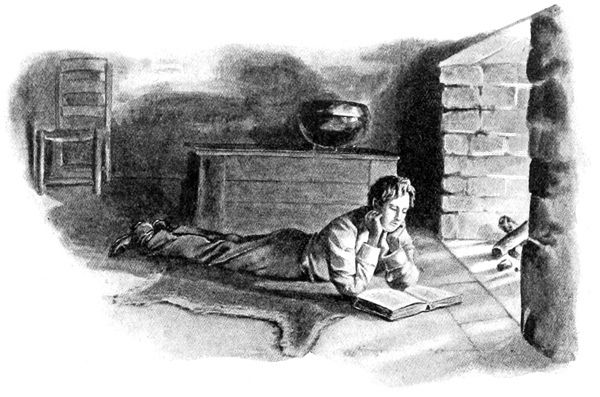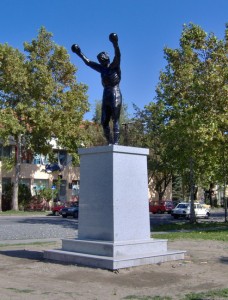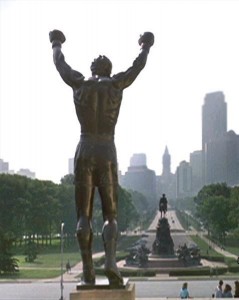 Rocky is much more than an iconic film in American culture. Rocky is representative and encyclopedic of a particular time and place. Rocky, the character and Rocky the movie are inextricably linked to the City of Philadelphia. I think few films have such a deep connection to a specific place, as does Rocky.
Rocky is much more than an iconic film in American culture. Rocky is representative and encyclopedic of a particular time and place. Rocky, the character and Rocky the movie are inextricably linked to the City of Philadelphia. I think few films have such a deep connection to a specific place, as does Rocky.
Philadelphia is much more than the setting of the Rocky (and Creed) franchise; it is an integral part of the movies that blurs plot and setting. In the case of Rocky, they’ve very much one and the same.
Philadelphia is Rocky. Rocky is Philadelphia.
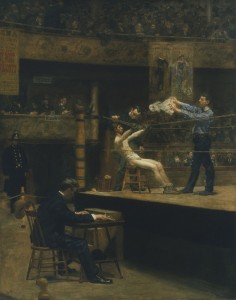 Not to mention Philadelphia’s long and storied legacy of boxing plays into the story. Much as the architecture of Frank Furness spoke to the industrial city of Philadelphia, melding the industrial with the beautiful. Rocky speaks to post-industrial Philadelphia. Rocky, like the city itself is down own his luck, but still trying to make something of himself, up against, and in the shadow of those better than him. Rocky puts up a good fight against Apollo Creed, but still ultimately loses. Philadelphia a once great city has long lagged behind its main competition New York in many ways for over two hundred years, but has slowly found its niche. “Stallone hit at the core of the matter in his comments on audience response to the film: ‘when they’re cheering for Rocky, they’re cheering for themselves’” (Leab 271).
Not to mention Philadelphia’s long and storied legacy of boxing plays into the story. Much as the architecture of Frank Furness spoke to the industrial city of Philadelphia, melding the industrial with the beautiful. Rocky speaks to post-industrial Philadelphia. Rocky, like the city itself is down own his luck, but still trying to make something of himself, up against, and in the shadow of those better than him. Rocky puts up a good fight against Apollo Creed, but still ultimately loses. Philadelphia a once great city has long lagged behind its main competition New York in many ways for over two hundred years, but has slowly found its niche. “Stallone hit at the core of the matter in his comments on audience response to the film: ‘when they’re cheering for Rocky, they’re cheering for themselves’” (Leab 271).
In his chapter on “The Blue Collar Ethnic in Bicentennial America”, historian Daniel Leab uses Rocky as his example. Leab’s picture of life in the 1970’s–particularly urban life in the 1970s, as a gloomy era when everything looked to be hopeless is part of the “Rocky narrative”, however, peaking through this darkness is some form of the American dream, some will to triumph and overcome. This same attitude is one that Philadelphia experienced during this time, coming to a very dark place at the time of Rocky, and then slowly rising up from that depression. In just the last census, conducted in 2010, Philadelphia five-decade population decline began to reverse. “Rocky’s life is bleak. He seems to have no future” (Leab 265). Despite the darkness in the film, critics and viewers see Rocky as “optimistic, idealistic, and sentimental” (Leab 269).
The character of Rocky Balboa is flawed and multidimensional, despite that the fact that he might not seem so at first look. Issues related particular to race, racism, and sexism, which in itself is an entire topic to delve into, but would be inappropriate not to mention. Especially given Rocky’s clear and specific depiction as an Ethnic White, the film’s relationship to Philadelphia, where race has long been a heated and difficult topic.
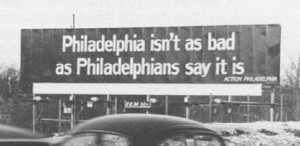 There’s a certain self deprecation and criticism from the community. Several individuals throughout the film call Rocky a bum. He ardently denies this claim. A marketing push for Philadelphia on billboards in the 1970s, which certainly didn’t speak well for the city, touted: “Philadelphia isn’t as bad as Philadelphians say it is”.
There’s a certain self deprecation and criticism from the community. Several individuals throughout the film call Rocky a bum. He ardently denies this claim. A marketing push for Philadelphia on billboards in the 1970s, which certainly didn’t speak well for the city, touted: “Philadelphia isn’t as bad as Philadelphians say it is”.
Rocky is a symbol of the city, this city, Philadelphia. But he is a symbol of this city at a very defined moment in its history. The once great industrial city, fallen and down. While Philadelphia has come back strong in many areas—a leader in healthcare, education, and culture, with a thriving tourism industry—where in fact tourists marvel in the sights of our nation’s founding, and make the trip up the Benjamin Franklin Parkway to, run, climb or walk the seventy-few steps of the Philadelphia Museum of Art. Visit Philadelphia proudly declares that in 2011, the steps were named the second most famous filming location in the world, second only to Grand Central Terminal in New York. At the same time, few tourists will venture away from Center City to experience the rest of Philadelphia; where over a quarter of city lives in poverty. The gritty image of the city, has sold well, and continues to do so. Five months after Rocky was released, they had earned over $50 million. And on top of that, Rocky still earns money (Leab 268). Even though much of the city has changed from the time of Rocky in 1976. Many Philadelphians still have a bleak future, and still live like Rocky. This further emphasizes that Rocky is not exclusively a snapshot of one place and one time, but part of the narrative of city; it’s not the story (or just the story) of a boxer, of a man; it is the city.
Sources
Leab, Daniel. “Reaffirming Traditional Values: The Blue Collar Worker in Bicentennial America: Rocky.” Hollywood’s America: Twentieth Century America Through Film. Ed. Steven Mintz and Randy Roberts. Hoboken: Wiley-Blackwell, 2010. 264-71. Print.
Eakins, Thomas. Between Rounds. 1899. Philadelphia Museum of Art, Philadelphia. Philadelphia Museum of Art. Web. 6 Apr. 2016.
Rocky Statue: https://s-media-cache-ak0.pinimg.com/736x/99/b9/85/99b985cf1dda1bf40cc294e7b75de9bb.jpg
Philadelphia Billboard: http://ilovebricks.blogspot.com/2011/05/philadelphia-isnt-as-bad-as.html

